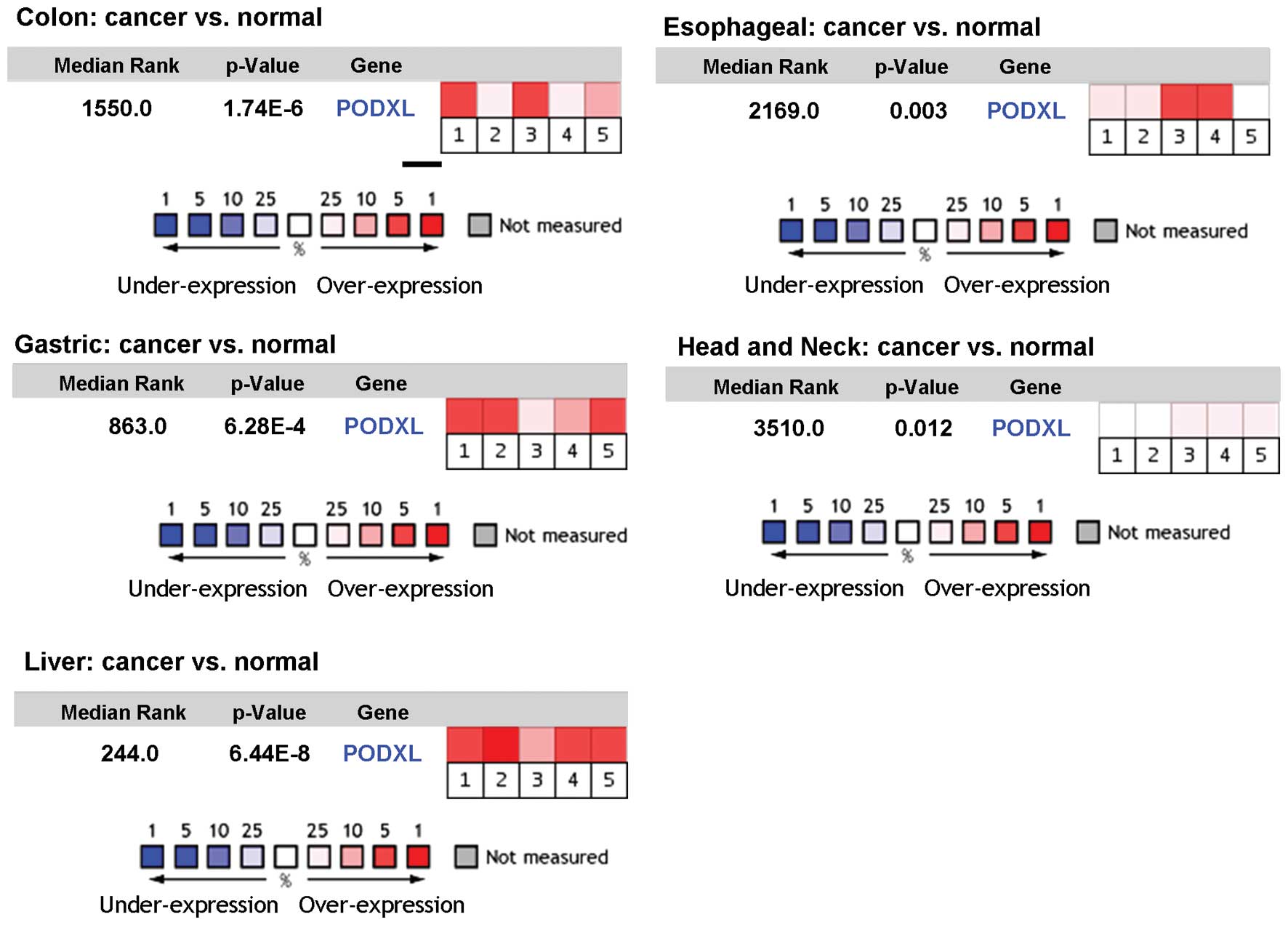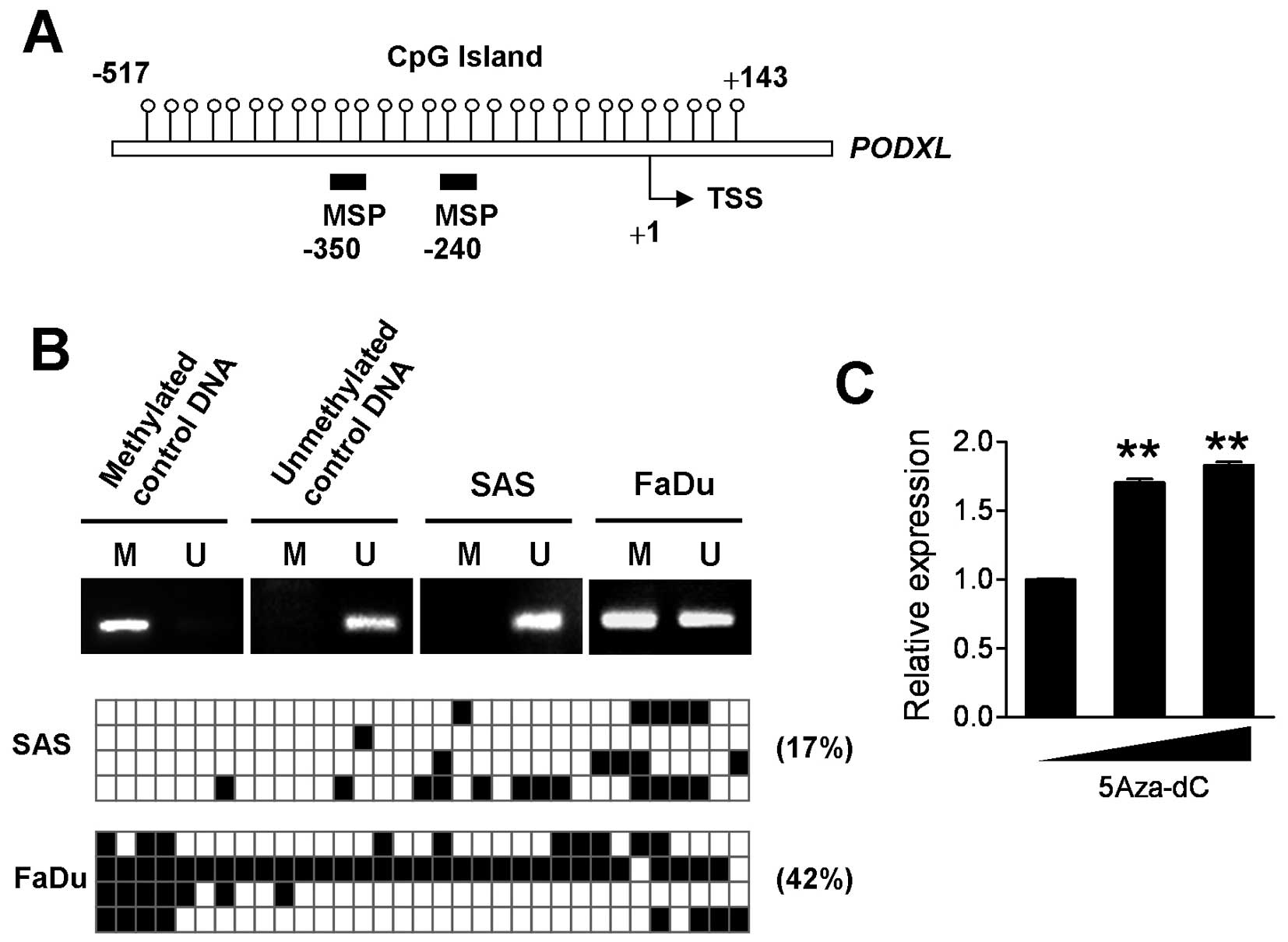|
1
|
Chen YJ, Chang JT, Liao CT, et al: Head
and neck cancer in the betel quid chewing area: recent advances in
molecular carcinogenesis. Cancer Sci. 99:1507–1514. 2008.
View Article : Google Scholar : PubMed/NCBI
|
|
2
|
Zygogianni AG, Kyrgias G, Karakitsos P, et
al: Oral squamous cell cancer: early detection and the role of
alcohol and smoking. Head Neck Oncol. 3:22011. View Article : Google Scholar : PubMed/NCBI
|
|
3
|
Fina L, Molgaard HV, Robertson D, et al:
Expression of the CD34 gene in vascular endothelial cells. Blood.
75:2417–2426. 1990.PubMed/NCBI
|
|
4
|
Labastie MC, Cortes F, Romeo PH, Dulac C
and Peault B: Molecular identity of hematopoietic precursor cells
emerging in the human embryo. Blood. 92:3624–3635. 1998.PubMed/NCBI
|
|
5
|
Kerjaschki D, Sharkey DJ and Farquhar MG:
Identification and characterization of podocalyxin - the major
sialoprotein of the renal glomerular epithelial cell. J Cell Biol.
98:1591–1596. 1984. View Article : Google Scholar : PubMed/NCBI
|
|
6
|
Doyonnas R, Nielsen JS, Chelliah S, et al:
Podocalyxin is a CD34-related marker of murine hematopoietic stem
cells and embryonic erythroid cells. Blood. 105:4170–4178. 2005.
View Article : Google Scholar : PubMed/NCBI
|
|
7
|
Nielsen JS and McNagny KM: The role of
podocalyxin in health and disease. J Am Soc Nephrol. 20:1669–1676.
2009. View Article : Google Scholar : PubMed/NCBI
|
|
8
|
Economou CG, Kitsiou PV, Tzinia AK, et al:
Enhanced podocalyxin expression alters the structure of podocyte
basal surface. J Cell Sci. 117:3281–3294. 2004. View Article : Google Scholar : PubMed/NCBI
|
|
9
|
Sizemore S, Cicek M, Sizemore N, Ng KP and
Casey G: Podocalyxin increases the aggressive phenotype of breast
and prostate cancer cells in vitro through its interaction with
ezrin. Cancer Res. 67:6183–6191. 2007. View Article : Google Scholar : PubMed/NCBI
|
|
10
|
Hsu YH, Lin WL, Hou YT, et al: Podocalyxin
EBP50 ezrin molecular complex enhances the metastatic potential of
renal cell carcinoma through recruiting Rac1 guanine nucleotide
exchange factor ARHGEF7. Am J Pathol. 176:3050–3061. 2010.
View Article : Google Scholar
|
|
11
|
Schmieder S, Nagai M, Orlando RA, Takeda T
and Farquhar MG: Podocalyxin activates RhoA and induces actin
reorganization through NHERF1 and Ezrin in MDCK cells. J Am Soc
Nephrol. 15:2289–2298. 2004. View Article : Google Scholar : PubMed/NCBI
|
|
12
|
Doyonnas R, Kershaw DB, Duhme C, et al:
Anuria, omphalocele, and perinatal lethality in mice lacking the
CD34-related protein podocalyxin. J Exp Med. 194:13–27. 2001.
View Article : Google Scholar : PubMed/NCBI
|
|
13
|
Forse CL, Yilmaz YE, Pinnaduwage D, et al:
Elevated expression of podocalyxin is associated with lymphatic
invasion, basal-like phenotype, and clinical outcome in axillary
lymph node-negative breast cancer. Breast Cancer Res Treat.
137:709–719. 2013. View Article : Google Scholar
|
|
14
|
Binder ZA, Siu IM, Eberhart CG, et al:
Podocalyxin-like protein is expressed in glioblastoma multiforme
stem-like cells and is associated with poor outcome. PLoS One.
8:e759452013. View Article : Google Scholar : PubMed/NCBI
|
|
15
|
Boman K, Larsson AH, Segersten U, et al:
Membranous expression of podocalyxin-like protein is an independent
factor of poor prognosis in urothelial bladder cancer. Br J Cancer.
108:2321–2328. 2013. View Article : Google Scholar : PubMed/NCBI
|
|
16
|
Larsson A, Johansson ME, Wangefjord S, et
al: Overexpression of podocalyxin-like protein is an independent
factor of poor prognosis in colorectal cancer. Br J Cancer.
105:666–672. 2011. View Article : Google Scholar : PubMed/NCBI
|
|
17
|
Chen QW, Zhu XY, Li YY and Meng ZQ:
Epigenetic regulation and cancer (Review). Oncol Rep. 31:523–532.
2014.
|
|
18
|
Jithesh PV, Risk JM, Schache AG, et al:
The epigenetic landscape of oral squamous cell carcinoma. Br J
Cancer. 108:370–379. 2013. View Article : Google Scholar : PubMed/NCBI
|
|
19
|
Huang TT, Gonzales CB, Gu F, et al:
Epigenetic deregulation of the anaplastic lymphoma kinase gene
modulates mesenchymal characteristics of oral squamous cell
carcinomas. Carcinogenesis. 34:1717–1727. 2013. View Article : Google Scholar : PubMed/NCBI
|
|
20
|
Towle R, Truong D, Hogg K, Robinson WP,
Poh CF and Garnis C: Global analysis of DNA methylation changes
during progression of oral cancer. Oral Oncol. 49:1033–1042. 2013.
View Article : Google Scholar : PubMed/NCBI
|
|
21
|
Hong Y, Downey T, Eu KW, Koh PK and Cheah
PY: A ‘metastasis-prone’ signature for early-stage mismatch-repair
proficient sporadic colorectal cancer patients and its implications
for possible therapeutics. Clin Exp Metastasis. 27:83–90. 2010.
|
|
22
|
Kaiser S, Park YK, Franklin JL, et al:
Transcriptional recapitulation and subversion of embryonic colon
development by mouse colon tumor models and human colon cancer.
Genome Biol. 8:R1312007. View Article : Google Scholar : PubMed/NCBI
|
|
23
|
Ki DH, Jeung HC, Park CH, et al: Whole
genome analysis for liver metastasis gene signatures in colorectal
cancer. Int J Cancer. 121:2005–2012. 2007. View Article : Google Scholar : PubMed/NCBI
|
|
24
|
Sabates-Bellver J, Van der Flier LG, de
Palo M, et al: Transcriptome profile of human colorectal adenomas.
Mol Cancer Res. 5:1263–1275. 2007. View Article : Google Scholar
|
|
25
|
Skrzypczak M, Goryca K, Rubel T, et al:
Modeling oncogenic signaling in colon tumors by multidirectional
analyses of microarray data directed for maximization of analytical
reliability. PLoS One. 5:pii: e13091. 2010. View Article : Google Scholar : PubMed/NCBI
|
|
26
|
Cho JY, Lim JY, Cheong JH, et al: Gene
expression signature-based prognostic risk score in gastric cancer.
Clin Cancer Res. 17:1850–1857. 2011. View Article : Google Scholar : PubMed/NCBI
|
|
27
|
D’Errico M, de Rinaldis E, Blasi MF, et
al: Genome-wide expression profile of sporadic gastric cancers with
microsatellite instability. Eur J Cancer. 45:461–469.
2009.PubMed/NCBI
|
|
28
|
Wang Q, Wen YG, Li DP, et al: Upregulated
INHBA expression is associated with poor survival in gastric
cancer. Med Oncol. 29:77–83. 2012. View Article : Google Scholar : PubMed/NCBI
|
|
29
|
Chen X, Cheung ST, So S, et al: Gene
expression patterns in human liver cancers. Mol Biol Cell.
13:1929–1939. 2002. View Article : Google Scholar PubMed/NCBI
|
|
30
|
Mas VR, Maluf DG, Archer KJ, et al: Genes
involved in viral carcinogenesis and tumor initiation in hepatitis
C virus-induced hepatocellular carcinoma. Mol Med. 15:85–94.
2009.PubMed/NCBI
|
|
31
|
Roessler S, Jia HL, Budhu A, et al: A
unique metastasis gene signature enables prediction of tumor
relapse in early-stage hepatocellular carcinoma patients. Cancer
Res. 70:10202–10212. 2010. View Article : Google Scholar
|
|
32
|
Wurmbach E, Chen YB, Khitrov G, et al:
Genome-wide molecular profiles of HCV-induced dysplasia and
hepatocellular carcinoma. Hepatology. 45:938–947. 2007. View Article : Google Scholar : PubMed/NCBI
|
|
33
|
Su H, Hu N, Yang HH, et al: Global gene
expression profiling and validation in esophageal squamous cell
carcinoma and its association with clinical phenotypes. Clin Cancer
Res. 17:2955–2966. 2011. View Article : Google Scholar : PubMed/NCBI
|
|
34
|
Hao Y, Triadafilopoulos G, Sahbaie P,
Young HS, Omary MB and Lowe AW: Gene expression profiling reveals
stromal genes expressed in common between Barrett’s esophagus and
adenocarcinoma. Gastroenterology. 131:925–933. 2006.PubMed/NCBI
|
|
35
|
Hu N, Clifford RJ, Yang HH, et al: Genome
wide analysis of DNA copy number neutral loss of heterozygosity
(CNNLOH) and its relation to gene expression in esophageal squamous
cell carcinoma. BMC Genomics. 11:5762010. View Article : Google Scholar : PubMed/NCBI
|
|
36
|
Kim SM, Park YY, Park ES, et al:
Prognostic biomarkers for esophageal adenocarcinoma identified by
analysis of tumor transcriptome. PLoS One. 5:e150742010. View Article : Google Scholar : PubMed/NCBI
|
|
37
|
Kimchi ET, Posner MC, Park JO, et al:
Progression of Barrett’s metaplasia to adenocarcinoma is associated
with the suppression of the transcriptional programs of epidermal
differentiation. Cancer Res. 65:3146–3154. 2005.
|
|
38
|
Cromer A, Carles A, Millon R, et al:
Identification of genes associated with tumorigenesis and
metastatic potential of hypopharyngeal cancer by microarray
analysis. Oncogene. 23:2484–2498. 2004. View Article : Google Scholar : PubMed/NCBI
|
|
39
|
Ginos MA, Page GP, Michalowicz BS, et al:
Identification of a gene expression signature associated with
recurrent disease in squamous cell carcinoma of the head and neck.
Cancer Res. 64:55–63. 2004. View Article : Google Scholar : PubMed/NCBI
|
|
40
|
Schlingemann J, Habtemichael N, Ittrich C,
et al: Patient-based cross-platform comparison of oligonucleotide
microarray expression profiles. Lab Invest. 85:1024–1039. 2005.
View Article : Google Scholar : PubMed/NCBI
|
|
41
|
Sengupta S, den Boon JA, Chen IH, et al:
Genome-wide expression profiling reveals EBV-associated inhibition
of MHC class I expression in nasopharyngeal carcinoma. Cancer Res.
66:7999–8006. 2006. View Article : Google Scholar : PubMed/NCBI
|
|
42
|
Toruner GA, Ulger C, Alkan M, et al:
Association between gene expression profile and tumor invasion in
oral squamous cell carcinoma. Cancer Genet Cytogenet. 154:27–35.
2004. View Article : Google Scholar : PubMed/NCBI
|
|
43
|
Murphy DA and Courtneidge SA: The ‘ins’
and ‘outs’ of podosomes and invadopodia: characteristics, formation
and function. Nat Rev Mol Cell Biol. 12:413–426. 2011.
|
|
44
|
Sung BH, Zhu X, Kaverina I and Weaver AM:
Cortactin controls cell motility and lamellipodial dynamics by
regulating ECM secretion. Curr Biol. 21:1460–1469. 2011. View Article : Google Scholar : PubMed/NCBI
|
|
45
|
Oser M, Yamaguchi H, Mader CC, et al:
Cortactin regulates cofilin and N-WASp activities to control the
stages of invadopodium assembly and maturation. J Cell Biol.
186:571–587. 2009. View Article : Google Scholar : PubMed/NCBI
|
|
46
|
Clark ES, Whigham AS, Yarbrough WG and
Weaver AM: Cortactin is an essential regulator of matrix
metalloproteinase secretion and extracellular matrix degradation in
invadopodia. Cancer Res. 67:4227–4235. 2007. View Article : Google Scholar : PubMed/NCBI
|
|
47
|
Dallas MR, Chen SH, Streppel MM, Sharma S,
Maitra A and Konstantopoulos K: Sialofucosylated podocalyxin is a
functional E- and L-selectin ligand expressed by metastatic
pancreatic cancer cells. Am J Physiol Cell Physiol. 303:C616–C624.
2012. View Article : Google Scholar : PubMed/NCBI
|
|
48
|
Thomas SN, Schnaar RL and Konstantopoulos
K: Podocalyxin-like protein is an E-/L-selectin ligand on colon
carcinoma cells: comparative biochemical properties of selectin
ligands in host and tumor cells. Am J Physiol Cell Physiol.
296:C505–C513. 2009. View Article : Google Scholar
|
|
49
|
Su PF, Huang WL, Wu HT, Wu CH, Liu TY and
Kao SY: p16(INK4A) promoter hypermethylation is associated with
invasiveness and prognosis of oral squamous cell carcinoma in an
age-dependent manner. Oral Oncol. 46:734–739. 2010. View Article : Google Scholar : PubMed/NCBI
|
|
50
|
Alyasiri NS, Ali A, Kazim Z, et al:
Aberrant promoter methylation of PTEN gene among Indian patients
with oral squamous cell carcinoma. Int J Biol Markers. 28:298–302.
2013. View Article : Google Scholar : PubMed/NCBI
|
|
51
|
Viswanathan M, Tsuchida N and Shanmugam G:
Promoter hypermethylation profile of tumor-associated genes p16,
p15, hMLH1, MGMT and E-cadherin in oral squamous cell carcinoma.
Int J Cancer. 105:41–46. 2003. View Article : Google Scholar : PubMed/NCBI
|
|
52
|
Butta N, Larrucea S, Alonso S, et al: Role
of transcription factor Sp1 and CpG methylation on the regulation
of the human podocalyxin gene promoter. BMC Mol Biol. 7:172006.
View Article : Google Scholar : PubMed/NCBI
|
|
53
|
Cao YX, Jean JC and Williams MC: Cytosine
methylation of an Sp1 site contributes to organ-specific and
cell-specific regulation of expression of the lung epithelial gene
t1alpha. Biochem J. 350:883–890. 2000. View Article : Google Scholar : PubMed/NCBI
|















